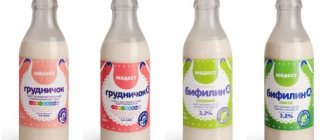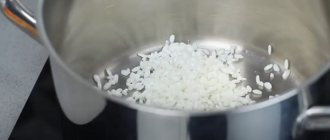Why should a child drink cow's milk?
Mother's milk supplies the baby with all the elements necessary for growth and development. Essentially, breast milk is food and drink at the same time. Since the baby drinks and eats breast milk, mothers feed him on demand. The natural product has a beneficial composition that changes as the child grows older, depending on the time of day and the well-being of the woman and baby. With a caloric content of 70 cal, it is saturated (per 100 g of product):
- fats (4.38 g);
- carbohydrates (6.90 g);
- protein (1 g);
- vitamins: A (60 mcg), beta-carotene (7 mcb), B1 (0.014 mg), B2 (0.037), B3 (0.178 mg), B5 (0.220 mg), B6 (0.010 mg), B9 (1.5 µg), B12 (0.05 µg), C (5 mg), E (0.08 mg), K (0.3 µg);
- calcium (30 mg);
- iron (0.03 mg);
- magnesium (3 mg);
- phosphorus (15 mg);
- potassium (51 mg);
- sodium (17 mg);
- zinc (0.17 mg)
It has been proven that the milk of a nursing woman contains more than 1000 components. Cow's milk contains 60 calories. Its composition is presented:
- fats (3.20 g);
- carbohydrates (5.1 g);
- proteins (3.3 g);
- vitamins: A (27 mcg), B1 (0.04 mg), B2 (0.17 mg), B12 (0.45 mcg), D (0.5 mcg);
- calcium (110 mg);
- magnesium (10 mg);
- potassium (143 mg);
- phosphorus (90 mg).
If we compare cow's and human milk, we can conclude that calves need strong bones, a healthy heart and blood vessels. Human breast milk is more aimed at the development of higher nervous activity.
Cow's milk contains more nutrients than a human baby needs, because a calf grows faster:
- Together with cow's milk, the baby's body receives 5 times more calcium than is required for normal development. In terms of phosphorus saturation, this figure exceeds 7 times. Excess calcium is eliminated from the body without problems, and getting rid of excess phosphorus is associated with the hard work of the kidneys, where calcium and vitamin D are also involved. A high concentration of phosphorus leads to an acute deficiency of these important components and threatens rickets.
- Proteins, minerals and other components that the child’s body does not need in large quantities are excreted through the kidneys. At the same time, an insufficiently developed urinary system experiences loads that are two to three times greater than the normal state.
The amount of iron that cow's milk contains is not enough for the body of newborns, which during feeding is expressed in a decrease in hemoglobin levels and causes iron deficiency anemia. Casein triggers the production of histamine, which threatens:
- intestinal bleeding, which even on a microscopic scale reduces hemoglobin levels;
- development of allergies.
Cow's milk is completely contraindicated for children under one year of age. However, from the age of three, the drink brings only benefits.
To find out whether children can have milk from a cow, you need to consult a pediatrician and a pediatric nutritionist. Milk formulas sold in stores that replace natural products have a number of advantages:
- They have a stable composition.
- Contains a full range of micro- and macroelements necessary for growth.
- Minimize allergic reactions.
Beneficial and harmful properties of cow's milk
This is a unique drink enriched with vitamins A, B, mineral elements, amino acids. 100 ml of milk contains: proteins - 3.3%, carbohydrates - 4.8%, fats - 3.7%. Calcium is almost completely absorbed by the body at 97%, which makes milk an indispensable product for both children and adults. The energy value of the product is 68.5 kilocalories per 100 ml.
At the same time, there is an insufficient amount of vitamins C, D and iron. This can lead to developmental delays, anemia, increased cholesterol levels, and negatively affect vision.
It is dangerous to drink fresh milk, as it can be contaminated (brucellosis), and it must be boiled. This irreplaceable healing product has other positive characteristics that help improve immunity, treat many diseases, are used in cosmetology for rejuvenation, improve memory, calm the nervous system, treat heart disease, stomach ulcers, gastritis, and also increase life expectancy.
There are also contraindications for people suffering from enzyme deficiency that breaks down lactose, allergy sufferers, and elderly people over fifty years of age. In this article we will cover the topic “When can you start giving your baby cow’s milk.” After all, there are so many benefits from it!
The benefits of milk for a child
The beneficial properties of milk are due to its rich composition. The main advantages of milk include the presence of easily digestible calcium, which strengthens bones and teeth. A lack of microelement leads to a decrease in bone mass by 5–10%, the risk of fractures increases, and in older age pathologies of the musculoskeletal system are possible. B vitamins are necessary for a child to:
- maintaining the functioning of the nervous and cardiovascular systems;
- improving the functioning of the gastrointestinal tract;
- maintaining emotional health during stress, depression, and increased emotional stress;
- · normal cellular growth, muscle function;
- strengthening the immune system, increasing the body's resistance to disease.
Immunoglobulins, lactalbumin, glycopeptides and other ingredients increase the body's protective functions. For the normal development of a growing child, protein is the main building material of cells and tissues. It is also invaluable in developing healthy digestive and immune systems.
Cow's milk is the only product that has no analogues that accelerates the development of intelligence. This is facilitated by tryptophan, an essential acid, which, by transforming into nicotinic acid, improves cerebral circulation and has a positive effect on the central nervous system.
It was experimentally found that regular consumption of warm milk by schoolchildren and students improves brain function five times and increases alertness.
When can you give milk to a baby?
Of course, no children, just like adults, are the same. Everyone has their own characteristics of character, temperament, and development. Therefore, to answer the question “When can you give milk to a newborn?” There is no way to be specific and unambiguous. Some people are ready to try it already at 9 months, but for others it is still not advisable to introduce cow’s or goat’s milk into their diet even after a year.
Your local pediatrician will be your best advisor. After all, he is the one who has been watching your child since his birth. And he knows about all the features of his development. Be sure to listen to his opinion. But from what you already know about milk, the conclusion suggests itself: there’s no point in rushing to introduce it to your baby.
While the child is called a baby, it is better not to give him either cow's or goat's milk. These are late complementary feeding products. And, in order to avoid the development of allergic processes in the baby’s body, they can be administered no earlier than nine months of age (or better, after the baby turns 1 year). According to all the rules for introducing any other complementary foods (start with 1 teaspoon and gradually increase the portion to the norm).
At what age can a child be given cow's milk?
Young parents often ask the question: at what age does cow’s milk become safe for babies? Most experts believe that the product is completely contraindicated for children under one year of age.
From what months should you introduce complementary foods?
Before introducing whole milk into your baby's complementary feeding, it is necessary to study the features and frequency of its supply. High-quality dairy products and dosage agreed with the doctor eliminate negative consequences and side effects.
A good example of replacing breast milk is infant formula, which contains minimal amounts of phosphorus, but is oversaturated with calcium and vitamin D. A specific dairy product corresponds to each age.
Cow's milk is contraindicated for children under three years of age if its consumption causes allergies and disrupts the functioning of the digestive system (constipation or diarrhea). It is excluded from the children's menu in case of renal pathologies and metabolic disorders. Fermented milk products are introduced into the child’s diet earlier:
- cottage cheese – from 6–7 months;
- kefir, fermented baked milk, natural yoghurts - from 8–9 months.
It is advisable to purchase them at a special dairy kitchen or prepare them yourself from regular store-bought pasteurized milk, the fat content of which does not exceed 1.5%.
Rules for introducing into children's diet
Complementary feeding with cow's milk begins with a minimum amount of 0.5 tsp. for 1 tsp. breast milk. After the first use, observe the reaction of the child’s body. At the slightest deviation, the drink is excluded from the diet.
If there are no negative manifestations, the dosage is adjusted to correspond to the age category by a gradual increase.
In case of acute and chronic diseases, as well as after preventive vaccinations, innovations in the baby’s menu are undesirable. Before introducing cow's milk into your child's diet, you should consult your pediatrician.
Cow's milk or formula?
Modern science is developing a variety of technologies for producing baby food. Many attempts have been made, but all these products could not fully replace mother's milk.
True, in recent years the mixtures have become as close as possible to the desired composition. Compared to cow's milk, baby food is considered absolutely safe at one year of age, since the baby's body is not yet fully strengthened.
When can you give cow's milk to your baby? Baby food today costs a lot of money; not everyone can afford to feed formula until they are 3 years old. To save money, after twelve months you can try introducing milk into your diet.
In what form should cow's milk be given?
You can give your baby cow's milk if it is purchased from a store specially designed for this purpose. It:
- guarantees high quality (raw materials are taken from healthy animals living in areas with good ecology);
- produced in strict compliance with sanitary standards;
- is subject to serious microbiological control;
- corresponds to the fat content optimal for children under 3 years of age (2.5–3.5%);
- It is distinguished by acidity, which complies with baby food standards (no more than 100 Turner degrees).
- undergoes ultra-pasteurization, which cleans the product from pathogenic microorganisms.
- stored in aseptic packaging.
How to properly introduce cow's milk into your diet
How to switch a child to cow's milk? Complementary feeding should be started with one teaspoon of milk diluted with water in a ratio of 1 to 3. If during the day there is no reaction from the body, then the portion can be gradually increased. After 2.5-3 weeks, the volume of milk consumed can be about 100 ml. Fat content should be within 3-4%. You can gradually reduce the amount of water and eventually remove it completely. If a child has an individual intolerance, you should refuse such a product and stop thinking about the question of when you can give cow’s milk to your child.
The gastrointestinal tract of a child under 2 years of age does not have the necessary enzymes that help fully digest animal products. Therefore, milk allergies are quite common. This happens due to the content of beta globulin in its composition - the main culprit of the rash. Amino acids from mother's milk are absorbed easily and quickly by the child's body, while enzyme systems need to work with increased load to break down foreign acids. Allergies are cumulative in nature, so they may not appear immediately.
Fermented milk products are introduced into a child’s diet before cow’s milk. This is due to the reduced amount of protein and lactose due to the manufacturing process. According to a number of studies, when cow's milk was introduced into the diet of children under 1 year of age, an allergy to this product developed in ¼ of the cases. This circumstance gives grounds to consider cow's milk one of the most allergenic products.
How to teach a child to drink milk
The baby may not like cow's milk the first time, since the taste of the new product differs from the usual breast milk or formula. If a child refuses milk, coercive measures are excluded. We need to try other methods:
- Reduce the number of breastfeedings.
- Mix cow's milk with breast milk or formula, gradually increasing the amount of the former.
- Offer milk in an unusual cup and bottle.
- Heat the drink to bring the taste of cow's milk closer to breast milk.
If unsuccessful, milk can be replaced with other products containing similar beneficial substances.
Cow's milk for babies (video)
In order for cow's milk to be fed to a newborn without harm to him, it must be diluted with water by half. At the same time, the nutritional and energy value of milk will decrease accordingly. The child will lack a number of important elements involved in the process of growth and development of his body.
In numbers it looks like this:
As you can see, cow's milk for infants is not so much a benefit as a harm. The consequences of its use as a maternal substitute may be irreversible. After all, various metabolic disorders in a child’s body are very, very difficult to treat. What's the deal with goat's milk?
Harm of cow's milk for a child
There are two main reasons why a child should not drink cow's milk.
Allergic reaction
Allergy to the protein component of cow's milk manifests itself in:
- Gastrointestinal diseases - diarrhea, vomiting, constipation, reflux;
- skin problems - hives, eczema, etc.;
- respiratory symptoms – persistent cough, wheezing;
- nervous disorders - lethargy, irritability, insomnia.
Clinical manifestations do not always develop immediately after feeding; sometimes an allergic reaction is observed several days after consuming the drink.











